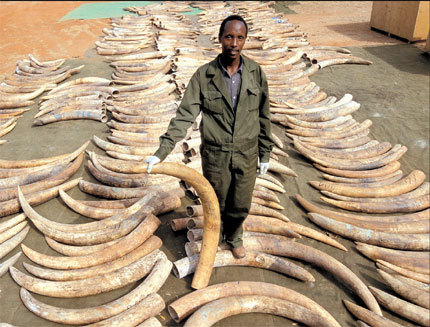Illegal ivory trade flourishes once again
 0 Comment(s)
0 Comment(s) Print
Print E-mail Shanghai Daily, February 17, 2012
E-mail Shanghai Daily, February 17, 2012
On a pillar in the Beijing Chengtian Antique City, a conspicuous warning is posted: Dealing in ivory and rhino horn products is strictly forbidden.
 |
|
In 2004, a member of the Kenya Wildlife Service team stands in the middle of ivory laid out for inspection and holds up a tusk. The ivory was confiscated in Singapore and returned to Kenya. |
According to a report commissioned by the Convention on International Trade in Endangered Species of Wild Fauna and Flora (CITES), China has surpassed Japan to become the world's largest consumer market for ivory products. The conclusion of the international body created to prevent exploitation of wildlife is not a superlative to be proud of.
In cities like Guangzhou and Fuzhou, ivory smuggling is rampant, with illegal raw materials channeled in from Malaysia, the Philippines, Thailand and Vietnam. Some of the smuggled ivory comes directly from Africa.
China is a particular target for ivory sellers, according to the International Fund for Animal Welfare. In September and October last year, the International Fund for Animal Welfare conducted investigations in Beijing, Shanghai, Guangzhou and Fuzhou, hoping to gauge the status of the ivory trade and compare its activity with data taken during similar probes undertaken since 2005.
The results were startling.
Of the 158 ivory factories and shops visited last year, only 57 were approved by the State Forestry Administration and the Ministry of Commerce. In other words, only one-third of the sites were legal.
Worse, even some companies licensed to do ivory trading were found to be selling contraband ivory products, the survey said. In fact, illegal deals outpaced legal ones six to one.
Ivory trade history
Ivory carving was part of China's culture long before anyone worried about the fate of the animals that produced it.
Even today, elephant ivory is prized here despite campaigns around the world to blackball a commodity that comes from the killing of endangered mammals. Some countries have banned ivory trading outright. China has been more equivocal in its response.In 1989, the CITES prohibited the global sales of ivory products by putting African elephants on its Appendix I, where items are strictly prohibited. The trade ban was in response to two-decades of rampant poaching to supply the ivory trade, which more than halved the population of elephants on the African continent.
But in 1997, a crack appeared in the hard line. CITES Parties at its conference that year approved proposals to down-list elephant populations in certain southern African countries to allow the so-called "one-off sales of ivory." In 1999, Japan purchased 54.6 tons of ivory from that sale, which came from Botswana, Namibia and Zimbabwe.
In 2007, CITES approved yet another stockpile sale and allowed China to join Japan to become a trading partner. At an auction in the subsequent year, a total of 102 tons of ivory from South Africa, Zimbabwe, Namibia and Botswana were purchased by China and Japan.
The sales came at the request of African countries that claimed they needed money to fund their animal-protection activities. At the same time, Asian countries - Japan and China in particular - said they lacked raw ivory to sustain their ancient arts of tusk carving.
To meet CITES requirement which enabled China to become a trading partner to participate in the 2008 sale, China enacted a new ivory registration system in 2005, where only operations that receive government licenses can engage in legal ivory trade. The system also requires that every piece of ivory sold need to have accompanying proper documentation or identity card.
The loosening of CITES regulations, originally aimed at improving the protection of wild animals, rescuing a dying art and fulfilling demand for ivory products in Asia, had more downside effects than intended.
It reignited the whole illegal ivory business and resulted in two species of elephants - Asian and African - being put on extinction alert by the International Union for Conservation of Nature.






Go to Forum >>0 Comment(s)